Title: WEAD ARTISTS PORTFOLIO
Open only to WEAD listing artists and members, each Portfolio is curated by the Editorial Committee to showcase artists whose work reflects diverse approaches to environmental and social justice art.
ARTISTS
Tanja Geis
Eliza Thomas
Lorna Stevens
Tessa Teixeira
Rainey Straus
Stephanie Garon
TANJA GEIS

Tanja Geis in her studio. Photo credit: Andrea Lo
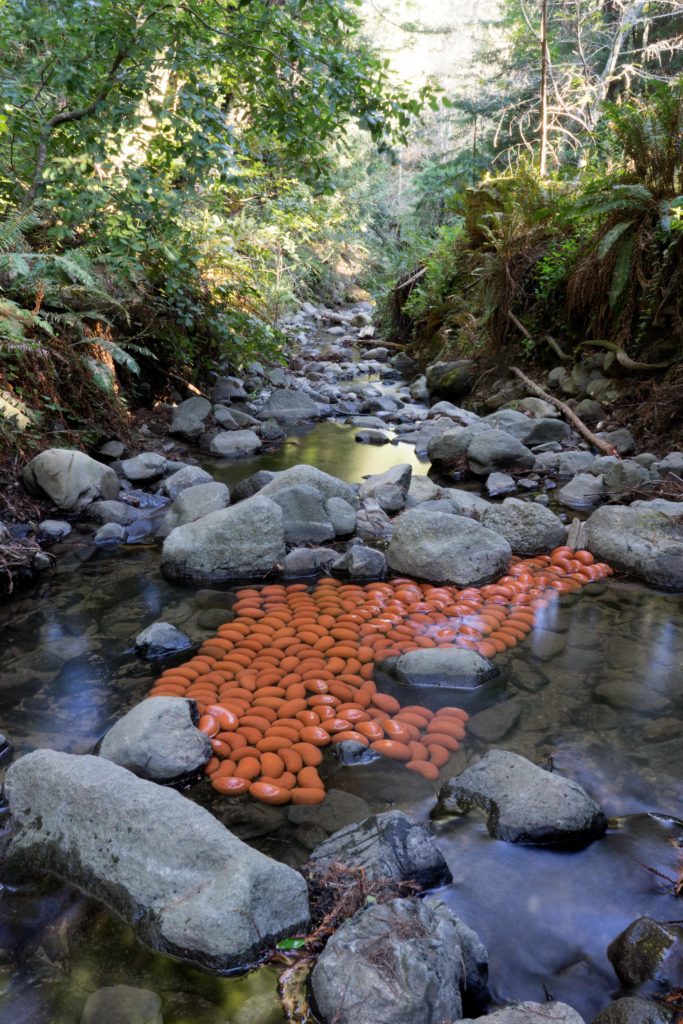
Archaea, 2018. Fired clay from mouth of San Gregorio Creek, variable dimensions. Permanent installation at Djerassi Resident Artists Program, Woodside, CA, USA. Photo credit: Tanja Geis
I make place-based paintings, drawings, sculpture, and videos that create opportunities for intimacy with human-disturbed ecosystems/spaces/species. Influenced by my past work in natural resource management, I am interested in how queering, drawing close to, and staying with the often overlooked or willfully ignored impacts of humans on the liveliness of non-humans might create a space for empathy and begin to transform our perception of our place in the ecological web. My process always begins with extensive research and time spent physically engaging with a place or species. The experiences, materials, artifacts, and imagery I collect during this research phase guide my creative trajectory and comprise the raw material for my work. In the studio these collections are transfigured physically and representationally into resonant mediums, ritual patterns, and anthropomorphic/zoomorphic forms. What new ways of seeing might help us live with grace in these mongrel ruins of our own creation?
ELIZA THOMAS
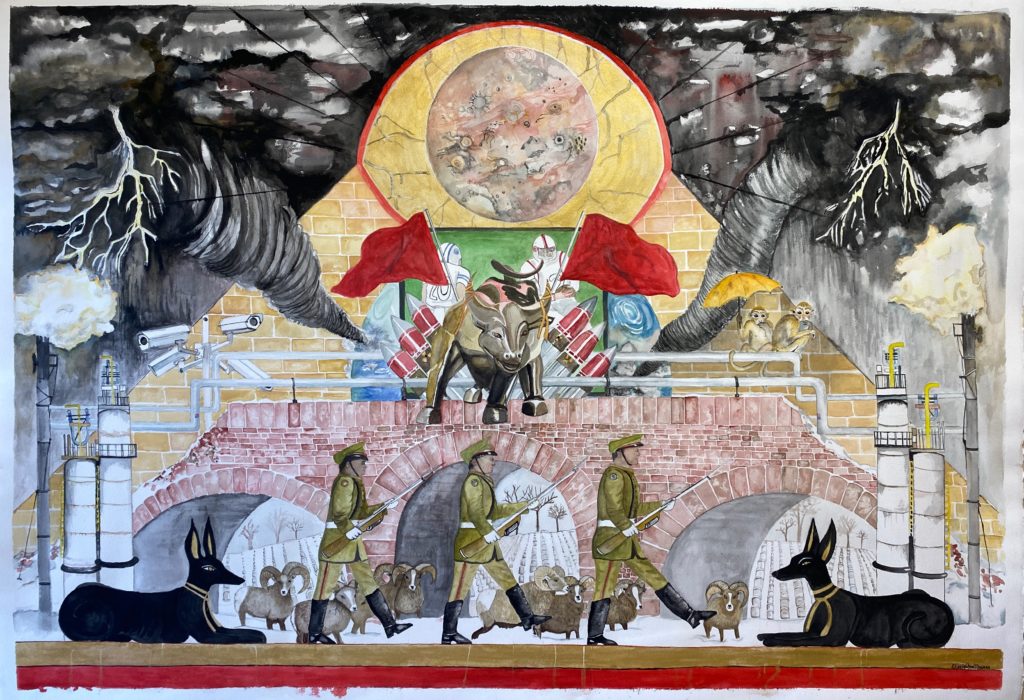
A Climate of War
‘A Climate of War’ fundamentally addresses our dependence on fossil fuels, gas and oil extraction. I am making the connection between war, as an industry, as a self perpetuating medium for multinational businesses to compete with each other.
The painting began as an environmental shout, a disturbing revelation that humanity is not perceiving climate change as catalyst for Anthropocene, despite obvious scientific evidence. Instead, we humans tend to compete with ourselves over unimportant issues with great passion and dedication. As the war in Syria, and Afghanistan, and others, fade from memory, and the war in Ukraine is in the forefront, we move all life on earth closer to its end. We are dangerously out of step.
We, caring human beings, are emotionally moved, inspired, motivated, by intense emotion. The powerful feeling of belonging to a group, or from cultivated empathy and a true desire for camaraderie across all peoples, or the strongest emotions, protecting innocent life, protecting ones home and family. These are the best parts of humanity, and we mostly support those in positive ways. In ‘A Climate of War’, those qualities are used to engage the attention of society, thereby distracting them, from the inevitable destabilization and destruction of our planet, from oil and gas, while we are set up to fight over it.
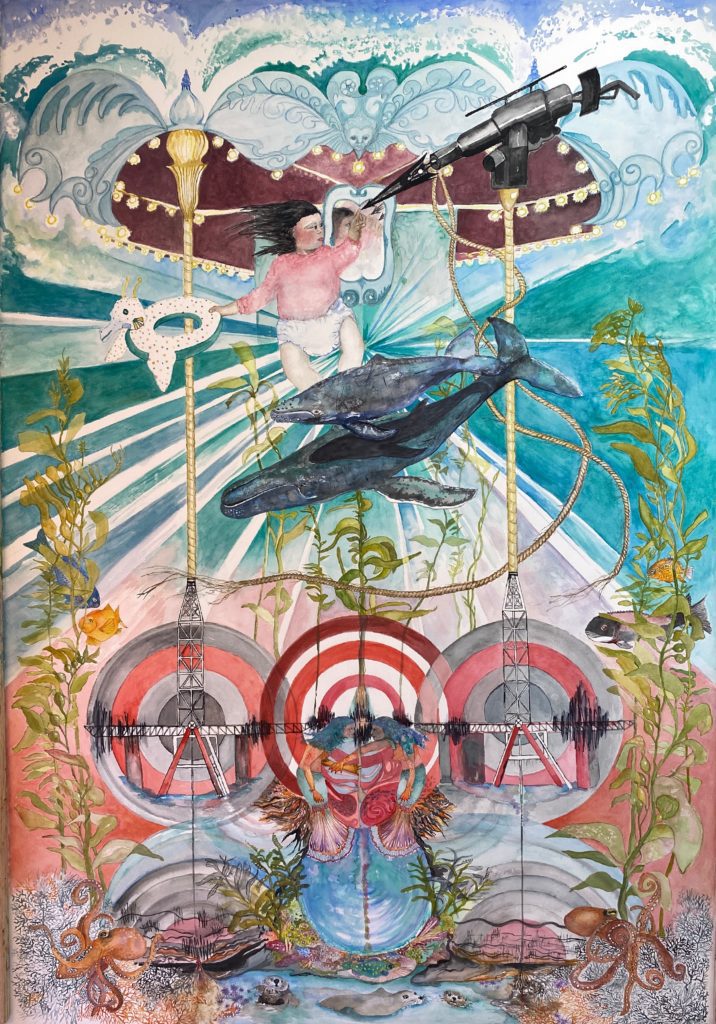
Taking the Blow
This work addresses health of our oceans. It’s calling out endurance, and tenacity, of younger generations work to bring climate change activism into a reality of sustainability. Face our challenges.
Marine life, particularly kelp forests of the Pacific North West, have seen devastating harm from human impact, beginning in the days of whaling for oil. The legacy of that drive, continues today, whale oil to petroleum.
Oil extraction practices have damaged balance in our seas. The push to find gas and oil deposits put us on the brink of disaster. Seismic blasts used to locate oil, create searing sound up to 250 decibels, carrying for miles underwater. These sounds damage millions of marine animals, everyday.
The United States alone, spills an average of 1.3 million gallons a year of crude oil from broken pipelines, boating accidents and drilling rig leaks. Marine life, along with the future generations, take the brunt of spills.
LORNA STEVENS

Hunt, 2011, wildebeest mane, pins, 14 x 14 x 5.5 inches. Photo: Lorna Stevens
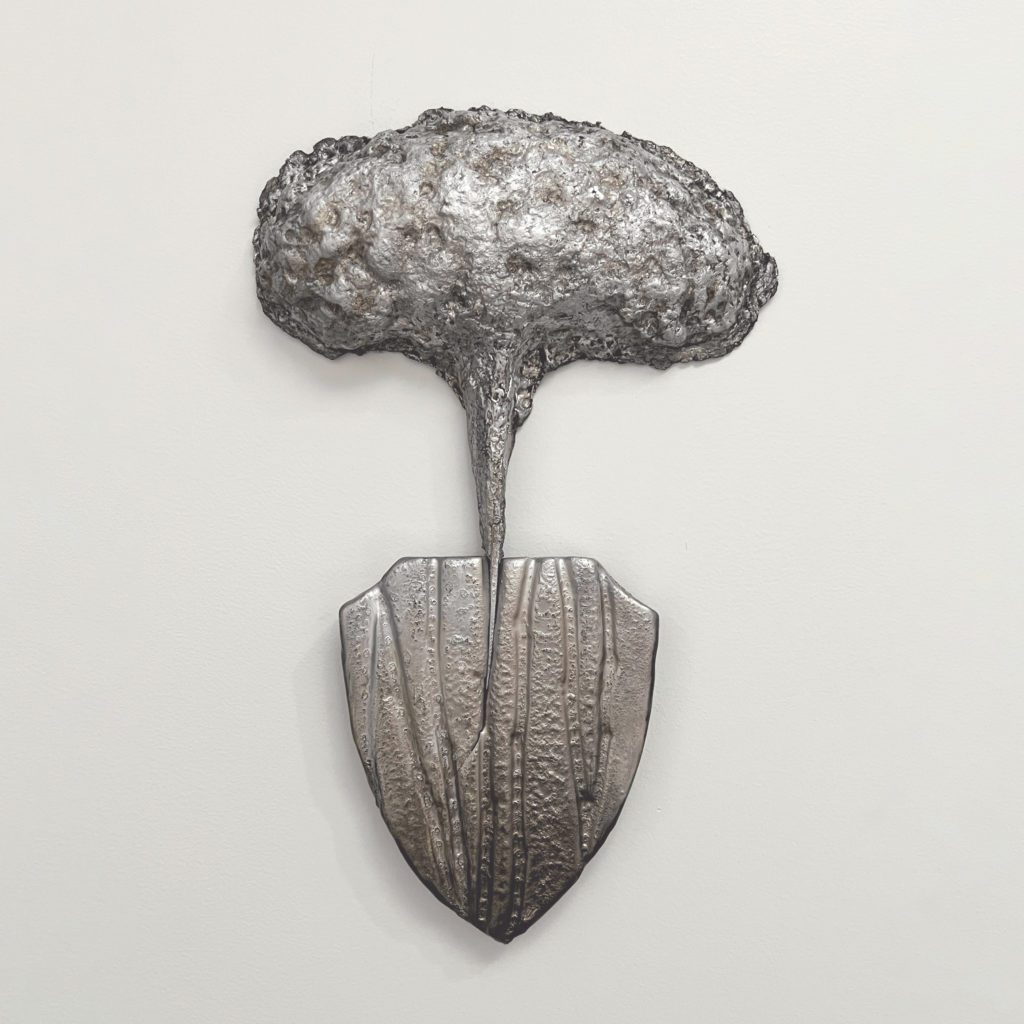
COVID, 2022, cast paper, ceramic, shim, paint, 16 x 10 x 2 inches. Photo: Lorna Stevens

Provider, 2015, US currency, shoe sole, 10 x 7.75 x .75 inches. Photo: Lorna Stevens

Bound to Please, 2005, sand cast glass with brass plaque and wire, 8 x 6.5 x 1.5 inches. Photo: Lorna Stevens
Lorna Stevens uses the structure of the wall mounted award plaque to visually comment on the human condition and the natural world.
Hunt, created from knotted strands of wildebeest mane, questions the sport of big game hunting and the desire to mount vanquished prey.
Provider, made from one-dollar bills and a shoe sole, recognizes those who give emotional and financial support, and the countless hours such commitments often require.
Bound to Please references the old custom of foot binding, a ritual resulting in permanently stunted foot growth to comply with the cultural ideal of tiny feet.
A recent addition, COVID, combines a failed element of another work with paper cast cauliflower to acknowledge the disruption and devastation of the pandemic.

You Are Already Inside This, 2022. Acrylic painting – 1400cm:1400cm:2.5cm
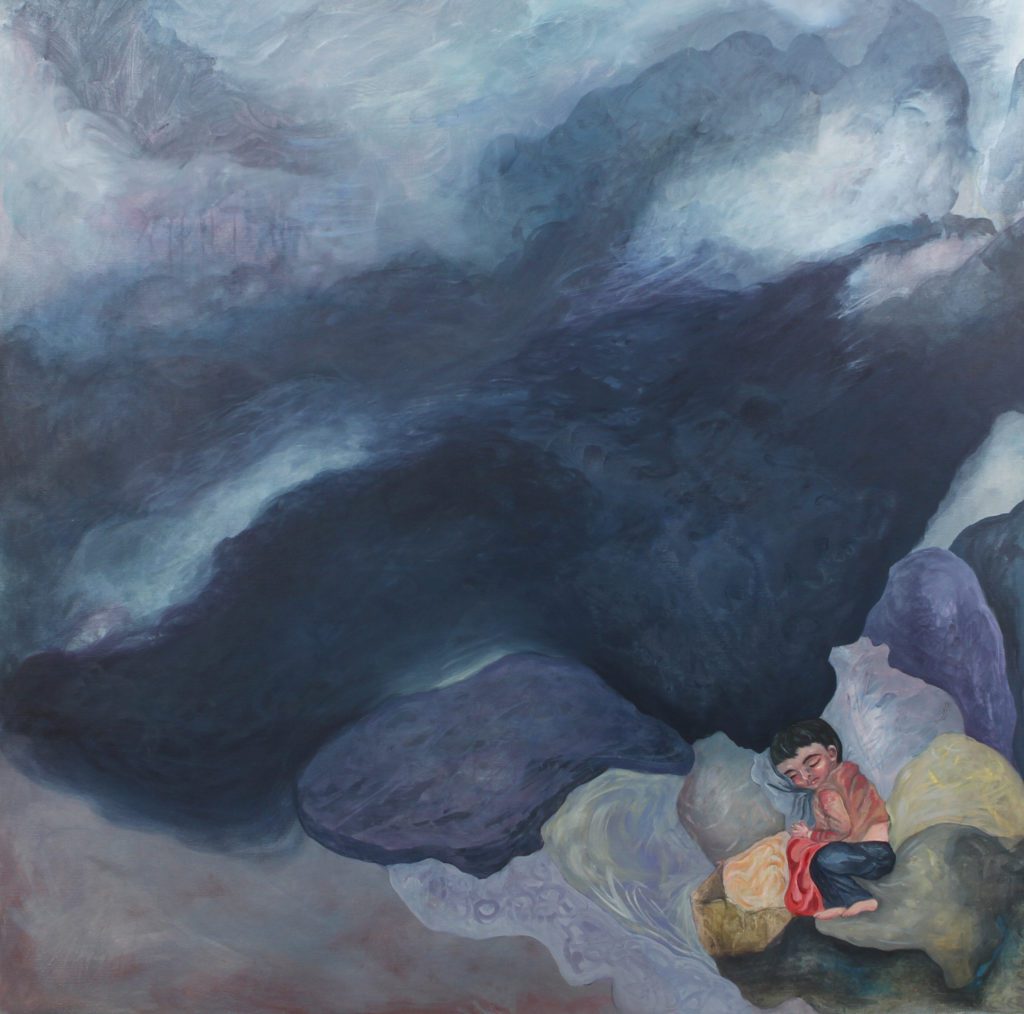
Anyone Can Become a Refugee, 2022. Acrylic Painting – 1400cm:1400cm:2.5cm
My current work is motivated by personal feelings I have felt and experienced over this decade when I have experienced extreme weather events in our Southern African region. The current La Nina, Pacific Ocean weather pattern has increased floods and cyclones. In the previous El Nino pattern, we experienced extreme water shortages in our cities due to extended drought conditions and apocalyptic wildfires in the Western Cape province.
Antonio Damasio writes in his book, ‘Feeling and Knowing: making minds conscious‘ that, ‘The power of feelings comes from the fact that they are present in the conscious mind: technically speaking, we feel because the mind is conscious, and we are conscious because there are feelings Feelings were and are at the beginning of an adventure called consciousness.’
Bill McKibben (1990) writes ‘Over the last century, human life has become a machine for burning petroleum. Humans have lived for thousands of years pyrotechnically. They have been burning, melting, mixing inanimate materials such as coal and iron, resulting in what can only be called runaway fossil fuel consumption.’ This has resulted in global climate increased temperatures.
Timothy Morton suggests in his book, ‘Hyper objects – philosophy and ecology after the end of the world‘ that global warming is the most dramatic example of hyper objects. ‘You cannot ‘see’ global warming. You only see snapshots of what is a very complex plot of a superset of algorithms that is executing themselves in high dimensional phase space.’ He says that the intensity of expressionist painting, poetry, music thus expresses something about hyper objects more effectively than any analytical, scientific document can’.
Materially I respond in my work by using materials that act in themselves as conceptual metaphors, in visually representing, and expressing these ideas, such as acrylic paint, cotton canvas, recycled plastic, and carbon capturing plants.
RAINEY STRAUS
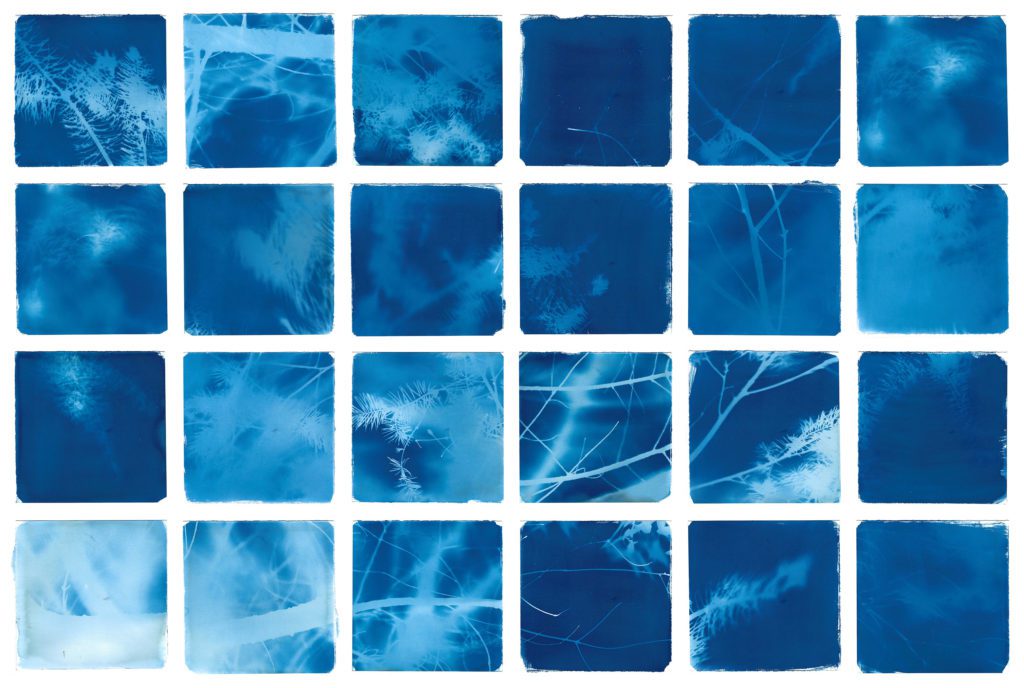
Meadow Trail Day 5: 04/06/2022 Cyanotype on Arches Platine Approximately 50′ W x 33′ H

Meadow Trail Day 3: 02/11/2022 Cyanotype on Arches Platine Approximately 50′ W x 33′ H

Meadow Trail Day 1: 12/10/2021 Cyanotype on Arches Platine Approximately 50′ W x 33′ H
My work is about creating intimacy with place. I believe that by re-situating the human within the sensuous living world, we can open to other ways of knowing, recognize what is at risk and begin to contemplate how to live on a changing planet. The Meadow Trail Project is an embodied inquiry into these ideas. The project consists of 8 days out on a trail at Point Reyes National Seashore that together map an approximately 30-foot-long installation. I walked this trail from December 2021 to June 2022 to experience the impact of the 2020 Woodward fire and to explore the forms and energies etched into the landscape in its aftermath. At each point along a trail, I produce multiple cyanotypes directly on paper that later in the studio come together to form the final composition.
The cameraless cyanotype process was developed in 1842 by scientist John Hershal and uses salts and the sun to produce images. The method was first used by the botanist (and first female photographer) Anna Atkins in 1843 to create images of algae. I am drawn to this process. Using simple salts and the sun to make images with nature feels deeply coherent to me — a nested methodology.
STEPHANIE GARON
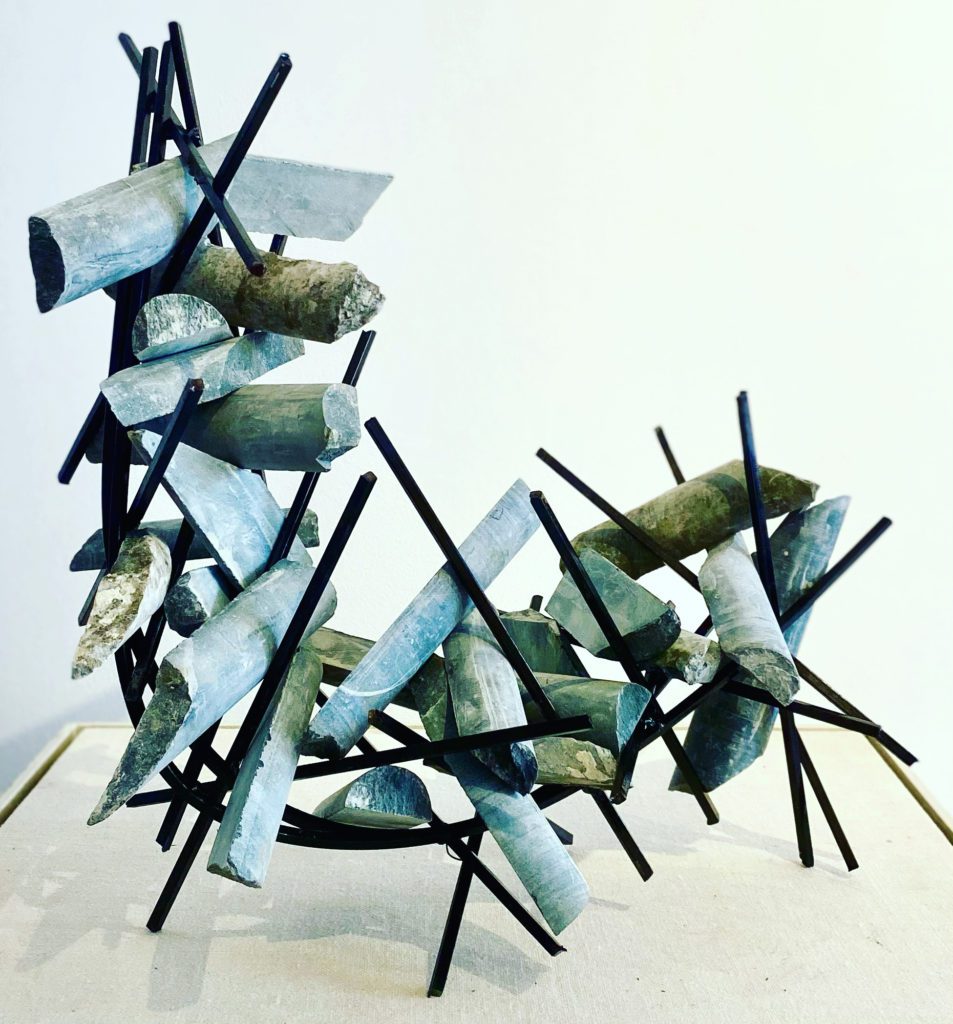
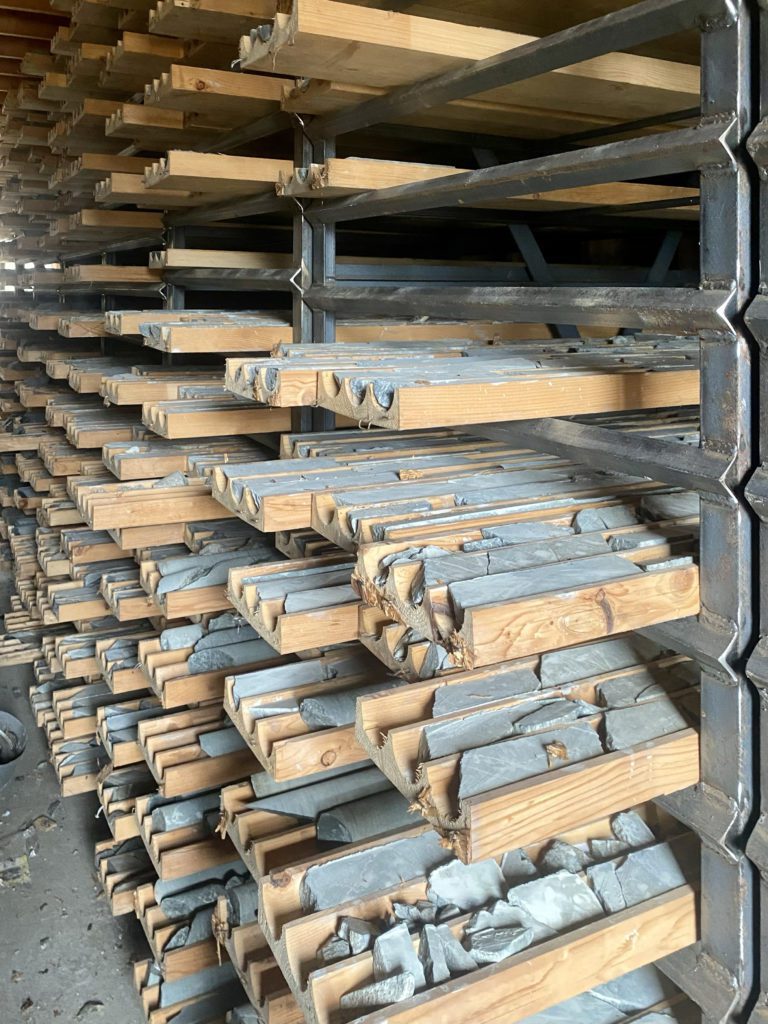
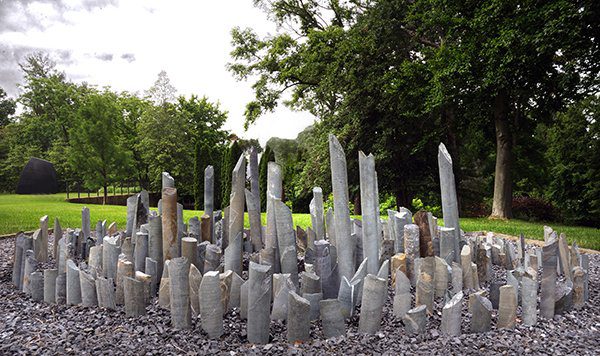
As an environmental artist, my artwork has centered on humanity’s interruption of nature with underlying themes of land claim, labor, and permanence. Last year, I was invited to develop artworks using thousands of mined rock cores from northeastern Maine/Passamaquoddy land. I worked with geologists, soil scientists, tribal members, and locals to better understand issues surrounding the rocks and create a touring exhibition.
Since the 1830s, at the height of the global gold rush, small towns have been approached by wealthy mining companies to source polymetallic minerals and rocks from the land. For each site, there have been economic, social, environmental, and historical repercussions. Extraction of rock has taken place on indigenous land and has caused significant economic and environmental devastation on these communities since the mining companies work for a short time period and then vacate the region. In its wake, local townspeople lose their jobs, acres of woods are felled, and water supplies are destroyed.
The cores, claimed from Indigenous Passamaquoddy land, were taken 150 years ago by one mining company searching for polymetallic minerals like gold, silver, and copper. Part of gold rush fever. In the 1970s, Golden Hope Mines took additional samples and in 2021, Wolfden Resources initiated their operation at Big Hill. The mine is located at the heart of the aquifer that supplies safe water for five surrounding towns and two reservations. These communities, spearheaded by Smithereen Farms which legally owns the cores, are fighting the mining company to protect the environment and their economy through a campaign organization called Pembroke Clean Water.
At The Kreeger Museum in Washington, DC, Void, a two dimensional drawing of the cavities of 324 extracted mine cores represent the number of mines located across Maryland and DC. Maryland mines are rich in iron, gold, copper, and silica while Maine rocks contain a large amount of gold, silver, copper and lead. Junior mining companies, like Wolfden, extract cores to assess content and then try to sell the site to global mining companies for higher stock prices. Last year, Pembroke Clean Water employees were confronted numerous times by Wolfden representatives and changed their locks three times to prevent thefts of the cores.
For additional information about my project, please feel free to visit www.garonstudio.com or @garonstudio
WEAD MAGAZINE ISSUE No. 13, THE ART OF EMPATHY
Published November 2022
